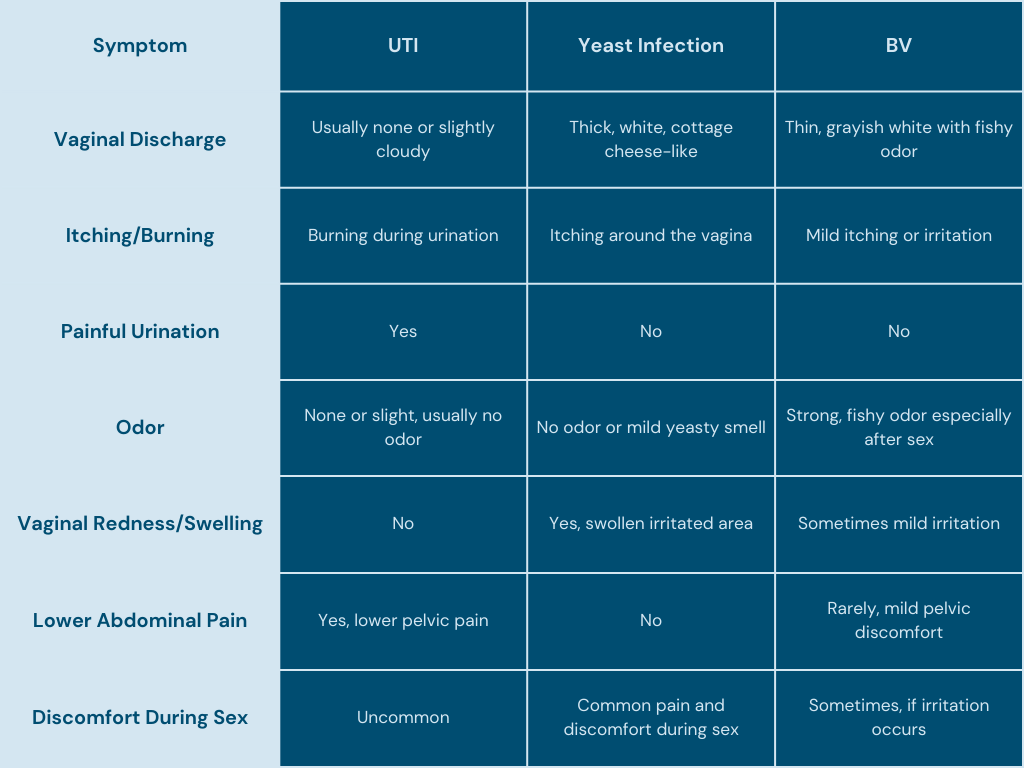When it comes to vaginal discomfort, understanding the difference between a UTI vs. yeast infection vs. BV (bacterial vaginosis) is important for getting the right treatment. A UTI (urinary tract infection) is caused by bacteria in the urinary system, leading to symptoms like painful urination and lower abdominal discomfort. Yeast infections, on the other hand, occur when the fungus Candida grows out of control, causing itching, irritation, and a thick, white discharge. BV is an imbalance of the normal bacteria in the vagina, often resulting in a fishy odor and thin, grayish discharge, and perhaps some itching and irritation, although less than a yeast infection.
While these conditions may share some symptoms, their causes and treatments are different. We’ll help you identify the problem and get the right treatment. Book an appointment for treatment with us today!
What is a UTI?
A UTI (urinary tract infection) is an infection in the urinary system, usually the bladder, caused by bacteria entering the urethra. UTIs occur when harmful bacteria enter the urethra and begin to multiply, leading to inflammation and discomfort.
Symptoms:
Symptoms of a UTI include frequent, painful urination with little output, cloudy or strong-smelling urine, and lower abdominal pain.
Does a UTI Cause Itching?
A UTI typically doesn’t cause itching. It is more commonly associated with symptoms like painful urination, frequent urination, and lower abdominal discomfort. Itching is more common with yeast infections or bacterial vaginosis, explained below.
Causes
Common causes include sexual activity, poor hygiene, douching, and holding urine for too long. The bacteria E. coli is the most frequent culprit. If untreated, a UTI can spread to the kidneys, so it’s important to seek treatment early.
Treatment
UTI treatment usually involves antibiotics prescribed by a doctor to kill the bacteria causing the infection. Over-the-counter pain relievers like ibuprofen can help ease discomfort. It’s important to complete the full course of antibiotics, even if symptoms improve, to fully clear the infection. If symptoms don’t improve within a few days of starting antibiotics, contact your healthcare provider.
Prevention
To prevent UTIs, stay hydrated, urinate after sex, and wipe front to back. Wear cotton underwear, avoid scented soaps and douches, and use mild, unscented soap. If you’re prone to UTIs, talk to your doctor about cranberry supplements or probiotics.
What is a Yeast Infection?
A yeast infection is caused by an overgrowth of the fungus Candida, which normally exists in small amounts in the body but can multiply when the balance is disrupted. This overgrowth typically occurs in warm, moist areas like the vagina, leading to symptoms such as itching, irritation, and a thick, white discharge.
Symptoms
Common symptoms of a yeast infection include itching and irritation around the vagina, a thick, white discharge (often described as cottage cheese-like), and pain or discomfort during urination or sexual intercourse. Some women may also experience redness and swelling of the vaginal area.
Common Causes
Yeast infections happen when a fungus called Candida overgrows in the vagina. While sex can be a factor, there are many other causes, like taking antibiotics (which kill good bacteria), hormonal changes from pregnancy or birth control, or wearing tight, sweaty clothes. Other risks include diabetes (especially if blood sugar is high), using scented products, or having a weakened immune system. Stress, poor diet, and lifestyle choices can also contribute, though yeast infections aren’t considered sexually transmitted.
Treatment
To cure a yeast infection, you may be prescribed antibiotics as treatment by your doctor. You can also try over the counter antifungal creams, ointments, or pills like Monistat. These usually work in a few days to a week. While treating, avoid scented soaps or douches, as they can make things worse. If it doesn’t get better or keeps coming back, see a doctor for more help.
Prevention
Avoid tight, damp clothing and change out of wet clothes quickly. Wear breathable cotton underwear and avoid scented soaps, sprays, or douches. Practice good hygiene by washing with mild, unscented soap, and try to reduce stress and maintain a balanced diet.

Need treatment for a UTI, Yeast Infection or BV?
Obria Medical Clinics offers low-cost treatment near you. Book today!
What is Bacterial Vaginosis (BV)?
Bacterial Vaginosis (BV) occurs when the balance of bacteria in the vagina is disrupted, leading to an overgrowth of harmful bacteria. This can cause symptoms like unusual discharge, a fishy odor, itching, and discomfort during sex or urination.
Common Symptoms
A thin, grayish-white vaginal discharge with a strong, fishy odor, especially after sex. You might also experience itching, irritation, or burning during urination. Some women don’t have any symptoms at all, but if you notice these signs, it’s a good idea to see a healthcare provider for diagnosis and treatment.
Common Causes
Bacterial vaginosis (BV) happens when the good bacteria in the vagina get out of balance, letting harmful bacteria grow. This can be caused by sex, using douches or certain soaps, taking antibiotics, or hormonal changes (like during pregnancy or menstruation). Other factors like smoking, a weak immune system, or types of birth control can also increase the risk. BV can happen to women whether or not they’re sexually active, and things like poor hygiene or medical conditions like diabetes can make it more likely.
Treatment
Bacterial vaginosis is treated with antibiotics, typically metronidazole or clindamycin, either as pills or creams. It’s important to finish the full course of treatment. BV can sometimes return, and your doctor may suggest additional treatments or lifestyle changes, like avoiding douching or scented products. If you’re pregnant or breastfeeding, consult your doctor for the safest options.
Prevention
Avoid douching and using scented soaps or sprays, as they can disrupt the natural balance of bacteria in the vagina. Wearing breathable cotton underwear and avoiding tight clothing can also help maintain a healthy vaginal environment. If you’re prone to BV, talk to your doctor about other preventive measures, like probiotics.
Symptom Overlap: When to See a Doctor
Some symptoms, like itching or pain during urination, can overlap between conditions like UTIs, yeast infections, and BV, making it hard to tell them apart. Since the treatments for each condition are different, it’s important to see a doctor for an accurate diagnosis and proper treatment.
Here’s a Simple Symptoms Comparison Table for UTI (Urinary Tract Infection), Yeast Infection, and Bacterial Vaginosis (BV):

Summary:
It’s important to understand the differences between a UTI, yeast infection, and BV because each requires different treatment. Though these conditions are common and treatable, seeing a healthcare provider is essential for proper diagnosis and care. Remember, seeking help is a positive step toward better health, and you’re not alone—many people experience these conditions and there are effective treatments available.
Experiencing UTI, yeast infection, or BV symptoms?
Visit Obria Medical Clinic for affordable, expert care near you. We’re here to treat you and help you feel better! Book now!

